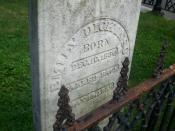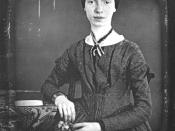Emily Dickinson was born and raised in Amherst, Massachusetts. She had lived and died there. She turned out to be a very reclusive person as her age progressed. Emily's personality has been described to be very unique and remote. Within her poetry, there is a connection between her every day life and the spiritual world. Similar to this poem is "Some keep the Sabbath going to church" which also showed her depiction of eternity. In her poem, "Because I could not stop for death," Emily showed how she would await for death and how calm and un-frightening it was.
In the first and second stanzas, Emily talked about how death approached her and how she had prepared for his arrival. "Because I could not stop for death/He kindly stopped for me," is how Emily personified death as a very kind, unhurried and civil gentleman.
Death approached her in a carriage with one extra companion, who was immortality: "The Carriage held but just Ourselves/And Immortality."
She believed that she would go to heaven and so that is the reason why Immortality accompanied her and death.
In stanza two, she said :
" We slowly drove- He knew no haste/
And I had put away/
My labor and my leisure too/
For His Civility."
In this stanza , Emily Dickinson was praising the calmness and civility of death who waited for her. Due to death's civility, she was able and willing to keep all her chores and leisure activities away for "His" arrival.
In stanzas three and four, the persona talked about how she had seen her life pass her (which is indicative of death). She saw the time when she was a child when she said, "We saw, where the children strove/ At Recess- in the Ring." To children, a...


